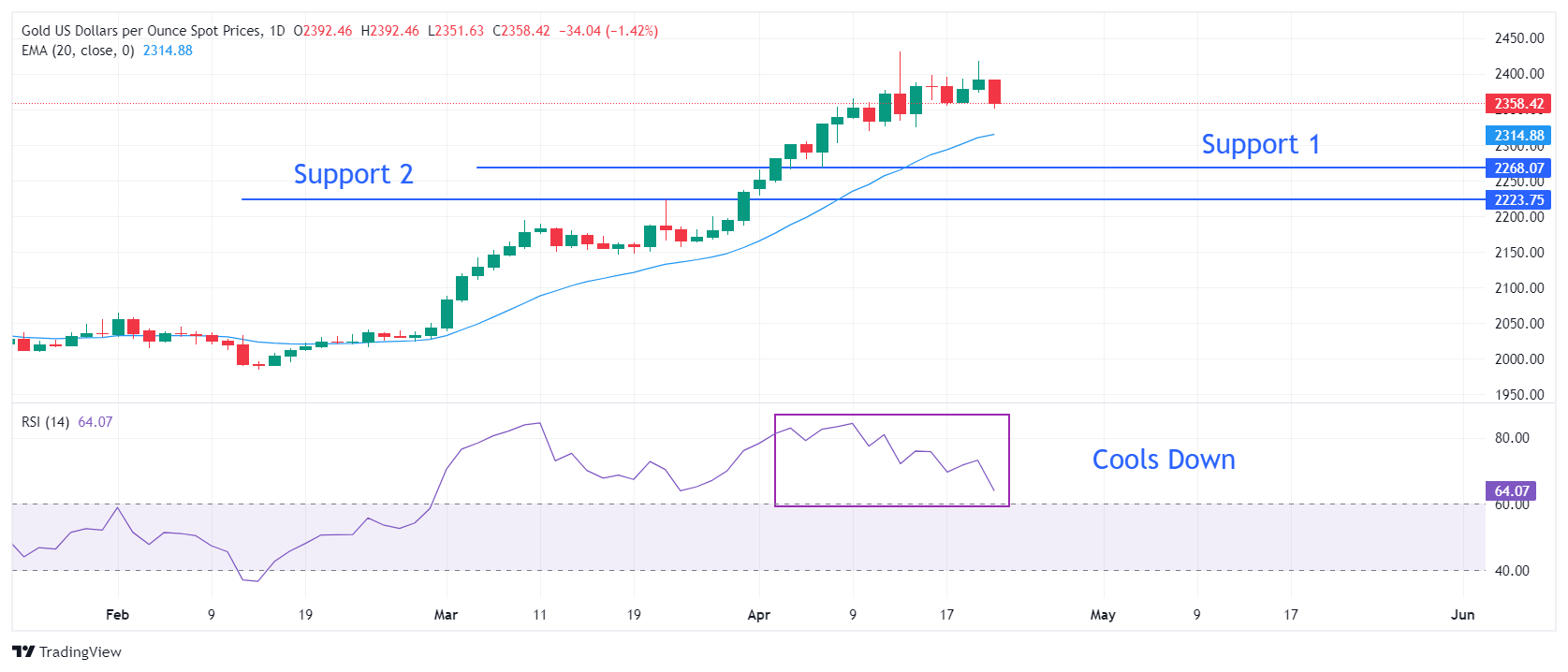Gold price tumbles as easing Middle East tensions dent safe-haven demand

- Gold price drops as investors see no immediate escalation in Israel-Iran tensions.
- Fizzling Fed rate cut prospects combined with easing geopolitical fears weigh on Gold.
- Fed’s Goolsbee said progress in taming inflation has stalled.
Gold price (XAU/USD) dips vertically after failing to recapture the crucial resistance of $2,400 in Monday’s early American session, driven by less safe-haven demand as Middle East tensions ease.
No further escalation in tensions between Iran and Israel has provided some relief to dismal market sentiment. Also, markets are increasingly pricing out the possibility that the Federal Reserve (Fed) will lower interest rates in the June and July meetings, further weighing on Gold.
10-year US Treasury yields rise to 4.66%. Yields on interest-bearish assets such as US bonds rise on firm prospects that the Fed could be a laggard in pivoting to rate cuts compared with other central banks from developed nations. Higher bond yields, in turn, weigh on non-yielding assets such as Gold as they become a less-attractive alternative to invest in.
This week, the United States core Personal Consumption Expenditure Price Index (PCE) data for March will likely move bond yields and Gold prices. As the Fed’s preferred inflation gauge, PCE data could shift expectations of when the US central bank will start lowering interest rates. According to the CME FedWatch tool, markets currently expect the Fed to make the move at its September meeting.
Meanwhile, the US Dollar Index (DXY), which tracks the US Dollar’s value against six major currencies, consolidates in a tight range around 106.00. Gold is a dollar-denominated asset, so a firm US Dollar tends to keep its price under control.
Going forward, investors will focus on the preliminary Q1 Gross Domestic Product (GDP) data, which will be published on Thursday. The US economy is estimated to have expanded by 2.5%. Strong growth exhibits robust consumer spending and higher production, which translates into higher price pressures. Higher GDP numbers would allow the Fed to keep interest rates at the current high levels, which will eventually improve the US Dollar’s demand.
Daily digest market movers: Gold price falls sharply while US yields rise
- Gold price tumbles to $2,350 after refreshing all-time highs near $2,430 as safe-haven demand diminishes. Investors are less worried about further escalation in Middle East tensions. On Friday, Tehran’s air defence said it destroyed a limited drone attack by Israel and confirmed no harm to nuclear facilities in the central region of Isfahan. Iran didn’t announce any plan for an immediate retaliation, so investors see no major escalation in the short term even as tensions between both parties persist.
- The precious metal comes under pressure after five weeks of gains as risk sentiment improves. The appeal for Gold has remained buoyant despite fading expectations that the Fed will reduce interest rates in June. Prospects for rate cuts in the June and July meetings have waned after the inflation report for March turned out hotter than expected.
- The recent inflation data have dented Fed policymakers’ confidence in inflation declining to the 2% target, with many of them saying they want to maintain interest rates higher for a longer period. On Friday, Chicago Fed Bank President Austan Goolsbee said: “Given the strength of the labor market and progress on easing inflation seen over a longer arc, I believe the Fed’s current restrictive monetary policy is appropriate,” Reuters reported.
- Goolsbee said that hotter-than-expected inflation data for the first three months of the year “can’t be dismissed.” He advised the Fed will need to determine if continued strong growth in the economy and job market is a sign of overheating.
Technical Analysis: Gold price drops to near $2,350
Gold price plunges to near $2,360 after retreating from $2,418. A mean-reversion move is anticipated in the yellow metal, which will drag it to the 20-day Exponential Moving Average (EMA) at around $2,315. Usually, the asset reverses to the 20-day EMA after a sharp rally. However, the move is generally considered a correction, not a bearish reversal.
On the downside, April 5 low near $2,268 and March 21 high at $2,223 will be major support areas.
The 14-period Relative Strength Index (RSI) cools down to 64.40 after turning extremely overbought. The overall outlook for the asset remains strong if the RSI shifts into the bullish range of 60.00-80.00.
Fed FAQs
Monetary policy in the US is shaped by the Federal Reserve (Fed). The Fed has two mandates: to achieve price stability and foster full employment. Its primary tool to achieve these goals is by adjusting interest rates. When prices are rising too quickly and inflation is above the Fed’s 2% target, it raises interest rates, increasing borrowing costs throughout the economy. This results in a stronger US Dollar (USD) as it makes the US a more attractive place for international investors to park their money. When inflation falls below 2% or the Unemployment Rate is too high, the Fed may lower interest rates to encourage borrowing, which weighs on the Greenback.
The Federal Reserve (Fed) holds eight policy meetings a year, where the Federal Open Market Committee (FOMC) assesses economic conditions and makes monetary policy decisions. The FOMC is attended by twelve Fed officials – the seven members of the Board of Governors, the president of the Federal Reserve Bank of New York, and four of the remaining eleven regional Reserve Bank presidents, who serve one-year terms on a rotating basis.
In extreme situations, the Federal Reserve may resort to a policy named Quantitative Easing (QE). QE is the process by which the Fed substantially increases the flow of credit in a stuck financial system. It is a non-standard policy measure used during crises or when inflation is extremely low. It was the Fed’s weapon of choice during the Great Financial Crisis in 2008. It involves the Fed printing more Dollars and using them to buy high grade bonds from financial institutions. QE usually weakens the US Dollar.
Quantitative tightening (QT) is the reverse process of QE, whereby the Federal Reserve stops buying bonds from financial institutions and does not reinvest the principal from the bonds it holds maturing, to purchase new bonds. It is usually positive for the value of the US Dollar.
Information on these pages contains forward-looking statements that involve risks and uncertainties. Markets and instruments profiled on this page are for informational purposes only and should not in any way come across as a recommendation to buy or sell in these assets. You should do your own thorough research before making any investment decisions. FXStreet does not in any way guarantee that this information is free from mistakes, errors, or material misstatements. It also does not guarantee that this information is of a timely nature. Investing in Open Markets involves a great deal of risk, including the loss of all or a portion of your investment, as well as emotional distress. All risks, losses and costs associated with investing, including total loss of principal, are your responsibility. The views and opinions expressed in this article are those of the authors and do not necessarily reflect the official policy or position of FXStreet nor its advertisers. The author will not be held responsible for information that is found at the end of links posted on this page.
If not otherwise explicitly mentioned in the body of the article, at the time of writing, the author has no position in any stock mentioned in this article and no business relationship with any company mentioned. The author has not received compensation for writing this article, other than from FXStreet.
FXStreet and the author do not provide personalized recommendations. The author makes no representations as to the accuracy, completeness, or suitability of this information. FXStreet and the author will not be liable for any errors, omissions or any losses, injuries or damages arising from this information and its display or use. Errors and omissions excepted.
The author and FXStreet are not registered investment advisors and nothing in this article is intended to be investment advice.




